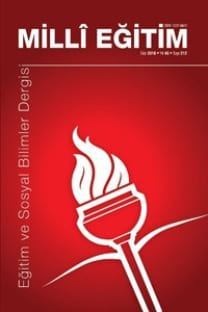Estonya’da Eğitim Teftiş Sistemi
Estonya, eğitim sistemi, eğitim teftiş sistemi, eğitim denetimi, müfettiş
Education Inspection System in Estonia
Estonia, education system, education inspection system, education supervision, inspector.,
___
- Best, J. W. (1970). Research in education. (2nd ed.) New Jersey: Prentice-Hall. (1st ed. 1959).
- Bhattacherjee, A. (2012). Social Science Research: Principles, Methods, and Practices (2nd Edition). USF Tampa Library Open Access Collections Textbooks Collections Book 3. University of South Florida.
- Büyüköztürk, Ş., Kılıç Çakmak, E., Akgün, Ö. E., Karadeniz, Ş. ve Demirel, F. (2014). Bilimsel Araştırma Yöntemleri (17. baskı). Ankara: Pegem Akademi.
- Cinoğlu, M. (2009). Eğitimin Bilimsel Temelleri. Çiçek Sağlam, A. (Ed.), Eğitim Bilimine Giriş (s. 183-200), (2. baskı). Ankara: Maya Akademi.
- Çetin, R. B., Konan, N. (2020). Farklı Ülkelerin Eğitim Denetimi Sistemlerine İlişkin Bir İnceleme. Scientific Educational Studies , 4(1) 45-77.
- Dal, S., Tekin, Y., Kıral, B. (2019). Türkiye ile Endonezya, Estonya, Yeni Zelanda ve Yunanistan Öğretmen Yetiştirme, Eğitim Yönetimi ve Denetimi Sistemlerinin Karşılaştırılması. Akademik Sosyal Araştırmalar Dergisi, Yıl: 7, Sayı: 94, Temmuz 2019, s. 540-556 ISSN: 2148-2489 http://dx.doi.org/10.16992/ASOS.15102
- Demirkasımoğlu, N. (2011). Türk eğitim sisteminde bir alt sistem olan denetim sisteminin seçilmiş bazı ülkelerin denetim sistemleri ile karşılaştırılması. Abant İzzet Baysal Üniversitesi Sosyal Bilimler Enstitüsü Sosyal Bilimler Enstitüsü Dergisi, 23, 23-48.
- Erlandson, D. A., Harris, E. L., Skipper, B. L., ve Allen, S. D. (1993). Doing naturalistic inquiry: A guide to methods. Sage Publications, Inc.
- Eurydice, (2015). Eğitimde Kalite Güvencesi: Avrupa'da Okul Değerlendirmesine İlişkin Politikalar ve Yaklaşımlar. Eurydice Raporu. Lüksemburg: Avrupa Birliği'nin Yayınlar Bürosu, http://dx.doi.org/10.2797/392074.
- Gardner, J.E. (1980). Training the new supervisors. New York.
- Gündüz, Y. ve Balyer, A., (2012). Türkiye’de ve Bazı Avrupa Ülkelerinde Müfettişlerin Yetiştirilme Süreci ve Karşılaşılan Sorunlar, Mersin Üniversitesi Eğitim Fakültesi Dergisi, Cilt 8, Sayı 1, Nisan 2012, ss.84-95.
- İleri, T., Ahısha, R. ve Karamustafaoğlu, O. (2017). PISA başarısı nelere bağlı? Estonya örneği. Jret, Eğitim ve Öğretim Araştırmaları Dergisi, Journal of Research in Education and Teaching, Şubat 2017 Cilt: 6 Sayı: 1 Makale No: 01 ISSN: 2146-9199
- Karasar, N. (2010). Bilimsel Araştırma Yöntemi. Ankara Nobel Yayınevi.
- May, T. (2010). Social research issues, methods and process. (3rd ed.). New York: Mc Graw Hill. (1st ed. 1993).
- MEB (2022) MEB'den Eğitimde Kalite için Dev Adım: Eğitimde Kalite Güvence Sistemi Kuruldu, Millî Eğitim Bakanlığı, Haberler, 2022. 20 Mart 2022 tarihinde https://tkb.meb.gov.tr/www/mebden-egitimde-kalite-icin-dev-adim-egitimde-kalite-guvence-sistemi-kuruldu/icerik/178 adresinden erişildi.
- MOER, (2021). Juhendmaterjal järelevalve teostamiseks (Denetim için Kılavuz Materyal), Ministry of Education and Research, Estonia. 21 Ocak 2022 tarihinde https://www.hm.ee/sites/default/files/juhendmaterjal_2021_veebi.pdf adresinden erişildi.
- NCEE. (2020). Brıef on Hıgh-Performıng Systems: Estonia, Legislative International Education Study Group, National Center on Education and the Economy. 2 Şubat 2022 tarihinde https://www.ncsl.org/Portals/1/Documents/educ/International_Ed_Study_Group _2020/Estonia/1.EstoniaProfileNCEE.pdf adresinden erişildi.
- OECD, (2016). Reviews of School Resources: Estonia 2016. 24 Ocak 2022 tarihinde https://www.oecd-ilibrary.org/education/oecd-reviews-of-school-resources-estonia-2016_9789264251731-en adresinden erişildi.
- OECD, (2019). PISA 2018 results: What students know and can do (Vol. 1). Paris: OECD Publishing. https://doi.org/10.1787/5f07c754-en.
- Santiago, P. (2016). The teaching workforce in Estonia, in OECD Reviews of School Resources: Estonia 2016, OECD Publishing, Paris. s.30 DOI: https://doi.org/10.1787/9789264251731-9-en
- Scott, J. (1990). A matter of record documentary sources in social research. Cambridge: Polity Press.
- SICI (2016) The Inspectorate of Education of Estonia, Tartu, 2016. 21 Ocak 2022 tarihinde https://www.sici-inspectorates.eu/getattachment/21147d5b-bc8d-49c8-8fc0-864d2d31cc01/The-Inspectorate-of-Education-2016-Estonia.pdf;.jpg;.aspx adresinden erişildi.
- SICI (2018) Country Profile ESTONIA, 2018. 20 Ocak 2022 tarihinde https://www.sici-inspectorates.eu/getattachment/6ec120e7-ea20-442c-9e6b-06025da12e58/Country-Profile-Estonia_2018.pdf;.jpg;.aspx adresinden erişildi.
- SICI. (2019). Cooperation between Estonia and the Netherlands, SICI Newsletter, September, 2019.
- SICI, (2022). Who we are and what we do. The Standing International Conference of Inspectorates, 20 Mart 2022 tarihinde https://www.sici-inspectorates.eu/About-us/Who-we-are-and-what-we-do adresinden erişildi.
- Tire, G. (2021). Estonia: A Positive PISA Experience In: Crato, N. (ed.) Improving a Country’s Education: PISA 2018 Results in 10 Countries. pp. 101–120. Springer (2020). https://doi.org/10.1007/978-3-030-59031-4_5.
- Van Bruggen, J. (2010) The role of school inspection in ensuring quality in education: past, present and future. In: Stoney S (eds), Slough: National Foundation for Educational Research, pp.119-137. 3 Şubat 2022 tarihinde http://www.cidree.org/fileadmin/ files/pdf/publications/YB_10__Beyond_Lisbon_2010.pdf adresinden erişildi.
- Van Dalen, D. B. (1966). Understanding educational research (2nd ed.). New York: McGraw-Hill. (1st ed. 1962).
- Yıldırım, A. ve Şimşek, H. (2013). Sosyal bilimlerde nitel araştırma yöntemleri (9. Baskı). Ankara: Seçkin Yayıncılık. (İlk baskı. 1999).
- ISSN: 1302-5600
- Yayın Aralığı: Yılda 4 Sayı
- Başlangıç: 1973
- Yayıncı: Milli Eğitim Bakanlığı
Okul Gelişimi Değerlendirme Uygulamalarının İncelenmesi
Elif DAŞCI SÖNMEZ, Tuba GOKMENOGLU
Ortaöğretime Geçiş Sınavlarındaki Fen Bilimleri Dersi Sorularının Bazı Değişkenlere Göre Analizi
Otantik Liderlik Ölçeği: Bir Ölçek Geliştirme Çalışması
Aslıhan YAVUZ ALICIOĞLU, Bünyamin BAVLI
Bireyselleştirilmiş Eğitim Programı ile İlgili Çalışmaların Eğilimleri: İçerik Analizi
Nazlı GÜN, Seraceddin Levent ZORLUOĞLU, Elif KAŞIKCI
Nurullah Genç’in “Omuzlarımda Dünya” İsimli Hâtırat Eserinde Değerler Eğitimi
Yunus Emre SAYAN, Mehmet Emin GÜNEL
Osmanlı Devleti Son Dönemi Öğretmen Okullarına Bir Bakış
Denetim Uygulamalarının Mesleki ve Etik İlkelere Uygunluğunun İncelenmesi
Öğretmenlerin Perspektifinden Okul Müdürlerinin Ders Denetimi: Bir Olgubilim Çalışması
